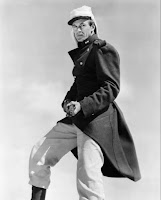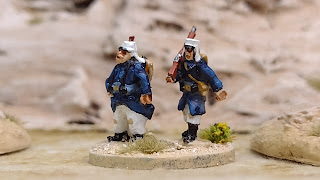Hollywood meets History
Fascination with the French Foreign Legion started long before Percival Christopher Wren’s novel Beau Geste was published in 1924. French troops in faraway exotic cities like Algiers & Oran to the almost semi-mythical Timbuktu could hardly fail to excite the imagination. But Wren's story of high adventure - set in pre-1914 French Algeria - took the romantic image to a new level, and it wasn’t long before the first screen adaption of his book was made in 1926 starring Ronald Coleman. Part of the success of the book was due to the detail of military life that Wren wove into his story, prompting unproven claims that he himself served in the Legion. A second adaptation of the story, starring Gary Cooper, was released in 1939 and this cemented the romantic image of the Foreign Legion in popular culture. However, the real story of this period of French Colonial history is much more interesting.
For much of the 19th Century, the government in Paris had been divided between liberals who saw no real need for expansion into North Africa and a conservative pro-colonization party that wanted land, no matter the cost. After the humiliation of the Franco-Prussian War, military adventurism in Europe was (for the time being at least) held in check and ambitious politicians and eager young officers looked outward for glory and career advancement opportunities.
French control of Algeria was maintained by the Armée d’Afrique. This consisted mostly of indigenous Arab or Berber volunteers as Mounted Spahis, Goumiers and Irregular infantry or Tirailleurs. These were supported by regiments of French settlers doing their military service (Zouaves and Chasseurs d'Afrique) and the non-French volunteers of the French Foreign Legion (Légion étrangère). It was not uncommon for officers in remote postings to overreact to minor incidents as a pretext for glory and the chance of promotion. And once these ‘French’ troops had taken a region, the government in Paris couldn’t abandon conquered territory without losing face. In this way, France acquired colonial conquests in a haphazard and unplanned fashion that has been described as an “orgy of military indiscipline”.
After the initial bloody occupation of the Touat, the tribes that had relied on trade with the region inevitably began to push back. The French occupiers had upset the delicate economics of the Sahara. To sustain their military forces the Armée d’Afrique was forced to transport vast amounts of supplies to a region that could barely support the local population, let alone their new European masters. This necessitated the acquisition of tens of thousands of camels, up to 40% of which died on the long treks south. For many Berbers, the majority of their personal wealth was invested in their camels. The requisitioning of animals lost to poor handling and often without adequate compensation, was a ruinous policy for many. In addition, the water of the Oasis chain could not sustain all the extra troops and camels, so the French sunk artesian wells which lowered the water table, simultaneously drying out the ground and creating stagnant disease-ridden pools on the surface. Little wonder that many of the indigenous population turned to raid as the only way to support their families.
Between 1904-7 BrigGen Lyautey was given increasing freedom of action with French military posts pushed further and further westwards, even across the debatable border into Morocco. On two occasions he reported the creation of recon outposts (soon to become permanent forts) using unmapped local names to conceal how far west he had pushed. Thus he ignored the official policy of the Foreign Ministry in Paris by shaping policy on the ground. Meanwhile, the rail line moved ever further south and west eventually, reaching Bechar in 1905. This supplied operations in the region for many years to come and solidified French control of this previously contested land.
With French incursions into Morocco, the Sultan began to face growing anti-french sentiment but was impotent to do anything about it. Corruption, lack of money and incompetence made the problem worse, eventually putting Europeans living in the major cities in danger. The French were eventually ‘forced’ to react, occupying Casablanca in 1907. This increased Arab anger both at the French and the Sultan, eventually resulting in a rival Sultan being proclaimed and a call for Jihad against the French. The Arabs were eventually defeated but by the end of 1908 the Sultan had abdicated, his wannabe usurper was dead, and Morocco was firmly on the road to becoming a French Protectorate.
The Beau Hunks Rules:
Whenever L&H end their movement in contact with an officer one of the players (or guest) around the table will draw 2 Chance Cards. There are three types of cards in the Chance deck:
- Jeanie-Weenie Cards - Pictures of the unfaithful heartbreaker, each dedicated to a different lover! Laurel & Hardy will gain Victory Points for each Jennie-Weenie card collected and if they get enough to win the game Hardy decides she wasn’t worth it after all and they get out of the Foreign Legion.
- Slapstick Cards describe various ridiculous events caused by the bumbling heroes. Some of these cards are just comic descriptions, but a handful has a limited effect on a single unit or officer in the game. These cards will be evenly subdivided into French Cards and Berber Cards. The opposing player gets to decide which enemy unit is affected. Some cards are immediate, but for those which indicate an effect in the following action phase, place the card by the officer as a reminder and remove it from the table once the action has been taken.
- Event Cards - Rare but significant events that affect all the units on the table.
Laurel and Hardy will gain Victory Points for each Jeanie-Weenie card found and could, potentially be declared the winners of the game, leaving the players to contest second and third place!
Recommended Historical Reading List:
The Conquest of the SaharaDouglas Porch (Farrar, Straus & Giroux 1984)
Our Friends Beneath the Sands
Martin Windrow (Weidenfeld & Nicolson 2010)
Uniforms of the French Foreign Legion
Martin Windrow (Blandford Press 1981)
The French Foreign Legion 1872-1914 Men-at-Arms Series No.461
Martin Windrow (Osprey 2010)
French Foreign Legionnaire 1890-1914 Warrior Series No.157
Martin Windrow (Osprey 2011)
Files for download:
- Show Leaflet
- TMWWBK's Quick Reference Sheet
- Unit Block Labels
- Beau Hunks Card Deck
- Askari Miniatures Guide to North African Dress (pdf file)
- French Foreign Legion Uniform Guide by 1898 Miniatures
- How to Paint French Foreign Legion by 1898 Miniatures
- French Foreign Legion Organisation Charts 1900-1914
- The Tuareg-Wanderers of the Desert (from Swiss Air Gazzette 1984)









Wow, that's a pretty comprehensive background in the French conquest if North Africa there Lee. The L&H content if your game looks loke great fun....I think I have probably seen the film, but it would have been getting on for fifty years ago...God I sound old, even to myself!
ReplyDeleteI agree with Keith. Fantastic background info on the FFL in Africa. Great merging of history and Hollywood. Well done!
DeleteBeau Hunks is available on YouTube if you want a laugh. Definitely my sort of humour!
DeleteSplendid..and in glorious 15mm!
ReplyDeleteThat was a conscious decision. The Blue Moon range is so nice I couldn't resist.
DeleteGreat report Lee, it was a grand day out for sure!
ReplyDeleteIt sure was. Five days on and I'm still buzzing.
DeleteMany thanks Lee, it looked great on the day, and congrats on best game!
ReplyDeleteThank you. It certainly made our day.
DeleteFantastic work Lee! Thanks for providing all the info. I've dabbled with similar in 6mm (https://majorballsuphobbyshed.blogspot.com/2022/03/marche-ou-creve-mon-braves-ambush-alley.html) and it's always good to know more. All the best, Andy.
ReplyDelete